10 Popular Chickens With Colored Eggs (+Color Chart)
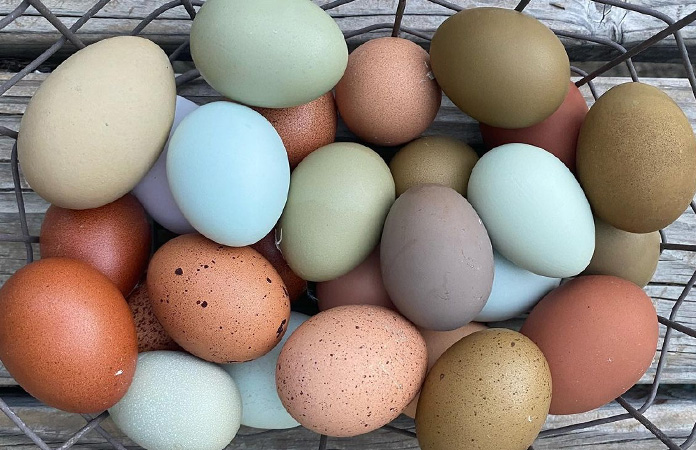
You won’t believe the stunning collection of colors some chickens can produce! From vibrant blues and greens to rich browns and even pinks and grays, these top chicken breeds will add a rainbow of colors to your egg basket. Let’s go over the best egg-laying chickens that lay stunningly colored eggs.
Read on to discover the 10 most popular colorful egg layers:
- Araucana
- Cream Legbar
- Olive Egger
- Easter Egger
- Marans
- Isbar
- Green Queen
- Prairie Bluebell Egger
- Faverolles
- Sapphire Gem
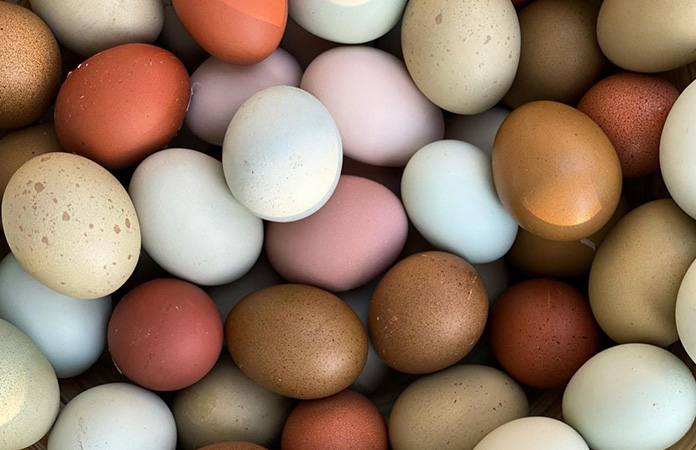
Egg Color Chart
Have you ever wondered why some chicken eggs are white, brown, blue, green, or even pink? It’s all determined by egg color genetics and varies depending on the breed of the chicken. Luckily, we have created a chicken egg color chart that overviews which breeds lay which colored eggs.
Get your free PDF here:
| Egg Colors Chart PDF | Description |
|---|---|
| Chicken Egg Colors Chart by Breed | Alphabetical list of chicken breeds, egg colors, size, and amount of eggs per year |
| Chicken Egg Colors Chart by Egg Color | List of chicken breeds grouped per egg color, listing size, and amount of eggs per year |
Let’s go over the most popular chicken breeds that lay colored eggs.
1. Araucana
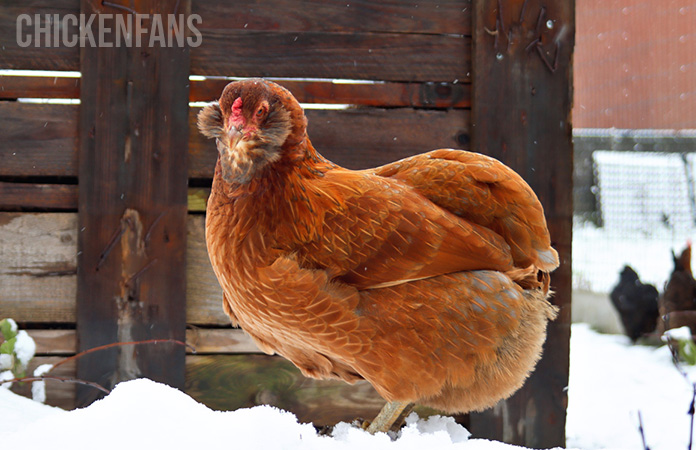
Few chicken breeds in the world can lay blue-shelled eggs, and Araucanas are one of them, which is why they’re so popular. Araucanas are medium-sized birds, not the heaviest or the tallest of the bunch, and have quite distinguished looks, with their ear tufts and lack of a tail.
| Eggs | 150 eggs per year |
| Egg Color | Light blue/green |
| Egg Size | Medium |
| Weight | 5.5 – 6.5 lbs |
| Hardiness | Cold |
| Temperament | Friendly, active |
| Beginner-friendly | Yes |
| Color | Varies |
An Araucana lays blue-colored eggs that are as blue on the inside as outside. The color of the egg is in the shell, not in the bloom, the protective layer on the outside of an egg.
The eggs of an Araucana can differ from bird to bird, and you’ll never know its color until your chicken lays its first egg. The color can vary between (very) light blue or green. Don’t be disappointed if the eggs of your Araucana are not bright blue; they usually lay very light blue or light green eggs.
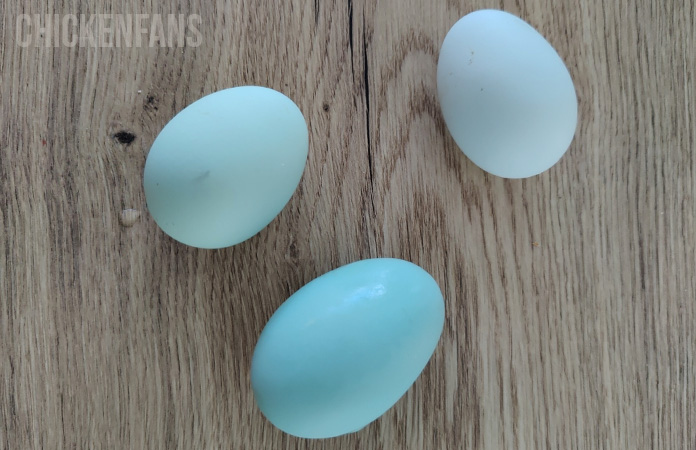
The blue egg color is caused by a (non-lethal) gene. Chickens that lay blue eggs have Dominant O in their genes on chromosome 1. Chickens with the blue egg gene will lay eggs that are blue on both the inside and outside of the shell.
While Araucana hens may not be the best egg-layers compared to breeds like Leghorns or the Rhode Island Red, they still produce up to three eggs per week. All eggs are medium-sized and light blue or green in color.
2. Cream Legbar
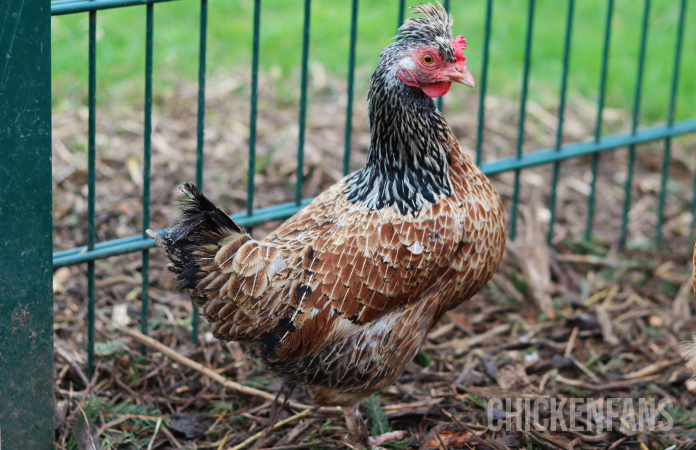
With its unique feather crest and ability to produce an abundance of blue to light-green eggs, the Cream Legbar will surely catch your attention. Cream Legbars are not a large chicken breed; they are medium-sized birds and the most popular auto-sexing breed in the world.
| Eggs | 250 eggs per year |
| Egg Color | Pastel-colored green to blue |
| Egg Size | Medium |
| Weight | 5.5 – 7.5 lbs |
| Hardiness | Cold & Heat |
| Temperament | Friendly |
| Beginner-friendly | Yes |
| Color | Cream-grey-gold-brown |
While it’s commonly said that Cream Legbars lay blue eggs, it’s important to note that the eggs’ true color ranges between light blue and light green. It’s best to describe a Cream Legbar as a pastel-colored egg layer.
Some hens may lay eggs with more of a greenish tint, while others produce blue eggs. Hens typically lay around 250 eggs yearly, that’s almost five eggs per week.
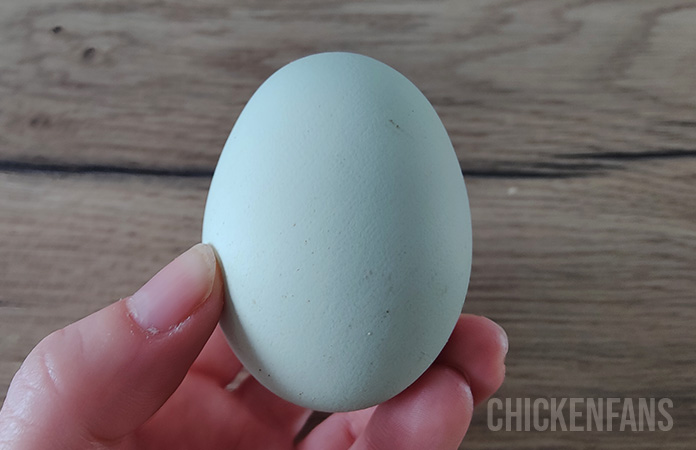
Cream Legbars are known for their friendly and docile temperament, making them a pleasure to have. They’re an excellent addition to any flock as they’re not skittish or prone to aggression. They love free-ranging, so keeping them in a larger backyard is best.
3. Olive Egger
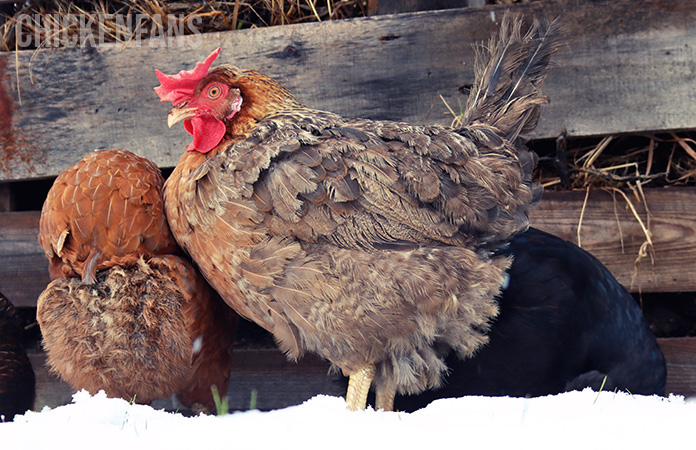
An Olive Egger isn’t a recognized chicken breed; it’s a hybrid resulting from crossing a dark brown egg-laying breed with a blue egg-laying breed. It’s a type of Easter Egger.
Olive Eggers are often a cross between a Marans chicken, known for their dark brown eggs, and an Araucana, which lays light blue eggs. Still, other possibilities are possible (for example: Barnevelder x Ameraucana).
| Eggs | 230 eggs per year |
| Egg Color | Green |
| Egg Size | Extra- large |
| Weight | 6 – 7 lbs |
| Hardiness | Cold |
| Temperament | Friendly |
| Beginner-friendly | Yes |
| Color | Greyish brown |
Olive Eggers are excellent egg layers, producing between 3 to 5 eggs per week. These eggs are typically large and always have a beautiful green color. The color tint ranges from light green to dark avocado to even gray (!), and everything in between.
Gray eggs in Olive Eggers happen when they lay eggs with a heavy bloom over the egg, so it appears grey. Once you wash the bloom off, the true color will appear.
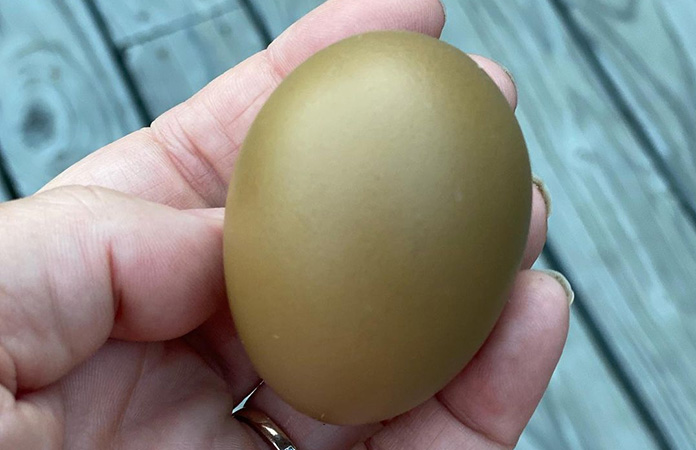
Olive Eggers are known for their resilience and keep laying eggs throughout winter, although their egg production rate may decrease. This means you can enjoy their beautiful green eggs almost year-round, making them an excellent addition to any flock.
4. Easter Egger
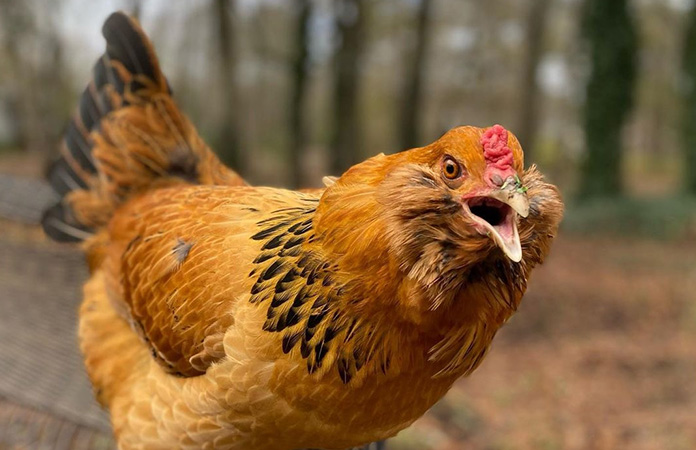
The Easter Egger, like the Olive Egger, is a hybrid chicken resulting from the crossing of one parent carrying the blue-egg gene. However, they are not exactly the same.
| Eggs | 200 eggs per year |
| Egg Color | Green and other pastel colors |
| Egg Size | Large |
| Weight | 6 – 7 lbs |
| Hardiness | Cold |
| Temperament | Friendly |
| Beginner-friendly | Yes |
| Color | Varies |
Olive Eggers are a specific type of Easter Eggers laying only green-ish eggs. So all Olive Eggers are a type of Easter Eggers, but not all Easter Eggers are Olive Eggers.
Easter Eggers are also a mix of one parent carrying the blue egg gene and another parent laying brown eggs, but they can produce a range of egg colors, including blue, green, and even pink.
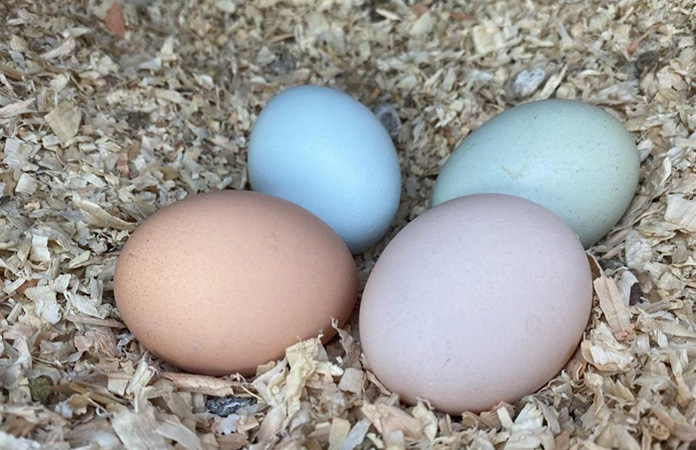
In addition to their beautiful range of colored eggs, Easter Eggers are excellent egg layers, typically producing 3 to 5 eggs per week. With a yearly amount of around 200 eggs, they’re a fantastic addition to any backyard flock.
5. Marans
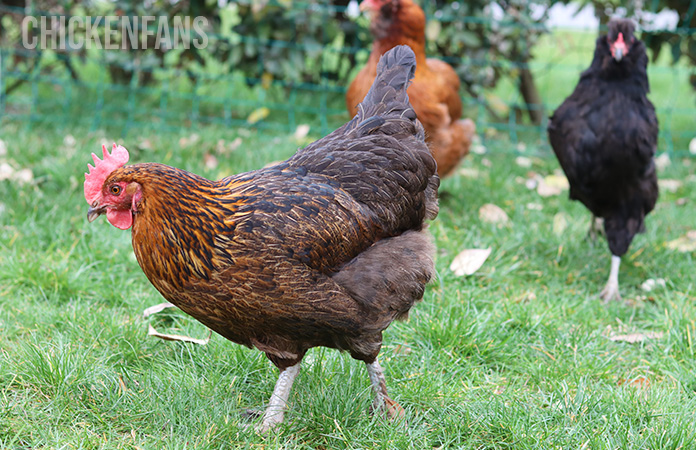
Marans chickens are a French breed and rather large chickens. They’re a dual-purpose breed that is kept both for eggs and meat and heavier than pure egg layers like ISA browns.
| Eggs | 200 eggs per year |
| Egg Color | Dark brown |
| Egg Size | Large |
| Weight | 5.5 – 8.5 lbs |
| Hardiness | Cold and warm |
| Temperament | Friendly, can be flighty |
| Beginner-friendly | Yes |
| Color | Varies |
The main reason for keeping Marans is their beautiful dark brown eggs. Most eggs are situated on the darker side of brown, but it’s exceptional for Marans to lay really dark brown eggs, as you see on Instagram.
Marans are good egg layers, producing up to 200 eggs per year, that is up to four eggs per week. Their eggs are large and feature a rich, chocolate-brown color. Marans are a cold-hardy breed, but they tend to decrease egg production during the winter months.
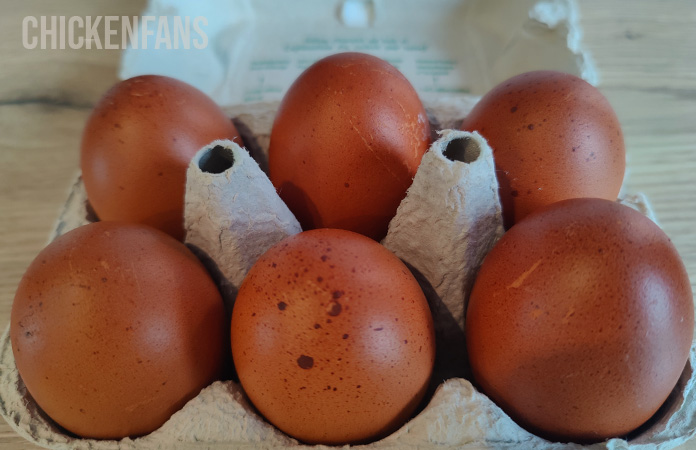
Marans chickens are generally sociable with their flockmates but can be skittish and flighty. While this trait makes them ideal for free-ranging, it can be a drawback if you have limited space in your backyard.
Hatcheries are currently creating many hybrid Marans, made to lay more eggs and look a certain way. The most known names are Midnight Majesty Marans, Mystic Marans, and Rustic Rambler.
6. Isbar / Silverudd Blå
Isbar chickens are quite large chickens but still medium-sized. They’re not a dual-purpose breed due to their poor meat quality, but are excellent egg layers. The Isbar is the only single-combed, green egg-laying chicken in the world.
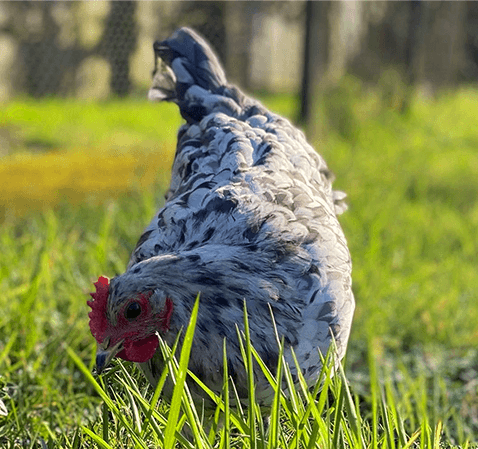
Silverudd Blå are decent egg layers, laying around 200 eggs per year, up to four per week. Being cold-hardy birds, hens will keep laying during the winter; however, egg production may slow down.
| Eggs | 200 eggs per year |
| Egg Color | Green |
| Egg Size | Large |
| Weight | 6 – 7 lbs |
| Hardiness | Cold |
| Temperament | Active and lively |
| Beginner-friendly | Yes |
| Color | Blue, Splash, and Black |
All eggs are large in size, and true Silverudd Blå birds should always lay green-tinted eggs. The egg may vary from very light green to olive but should never be brown. Brown eggs in a Silverudd Blå means the bird lacks the dominant blue-egg gene and isn’t correctly or purely bred.
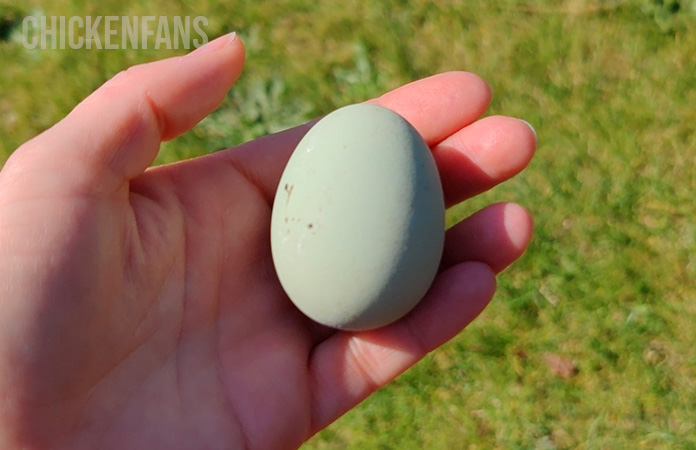
Silverudd Blå chickens are energetic birds that love free-ranging. While they can tolerate confinement, they do require more space to wander and forage. It’s not recommended to keep Silverudd Blå chickens in a small backyard.
If you want to learn more about Swedish chicken breeds, please check out our articles on the Hedemora chicken, 55 Flowery and Swedish Flower Hen.
7. Green Queen
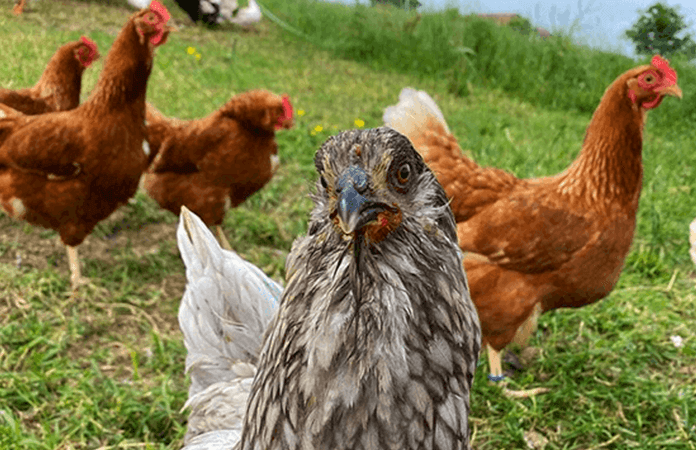
Green Queen chickens were bred to create a new variety of the Easter Egger, which gains popularity each day because of its amazingly colored eggs. Green Queens are a mix of different breeds, a hybrid chicken, and their looks can be confusing, as none look alike. But they have some things in common. They’re all medium-sized birds with distinguished muffs and beards.
| Eggs | 310 eggs per year |
| Egg Color | Green |
| Egg Size | Medium to large |
| Weight | 4 – 4.5 lbs |
| Hardiness | Cold/heat |
| Temperament | Friendly, docile |
| Beginner-friendly | Yes |
| Color | Varies |
Meyer Hatchery created the Green Queen and brought it to its customers in 2020, but they do not specify which breeds were used to develop the Green Queen. But, because this chicken lays green eggs, we can be sure that one of its parents carries the ‘blue egg laying gene‘, like Araucanas or Ameraucanas.
Green Queens are excellent layers. They lay up to 4 to 6 eggs per week, more than 300 annually! All eggs are medium to large-sized. Green Queen chickens lay green to olive-colored eggs, depending on chicken to chicken.
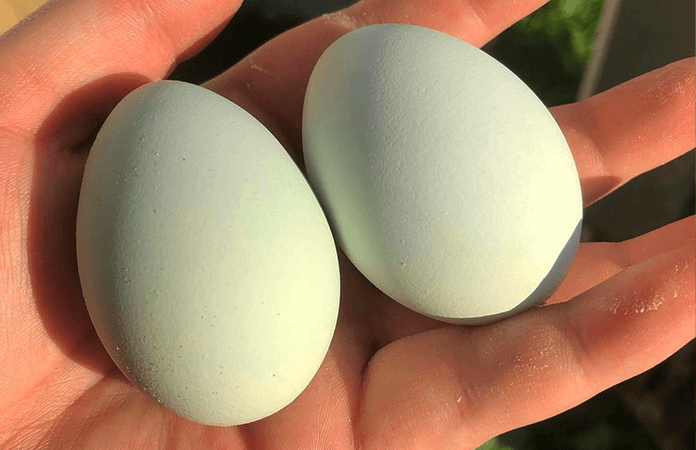
Green Queen chickens are calm and docile, which makes them happy in confinement, but they’re also great foragers. If you have the space, you can let them free-range without any issues.
8. Prairie Bluebell Egger
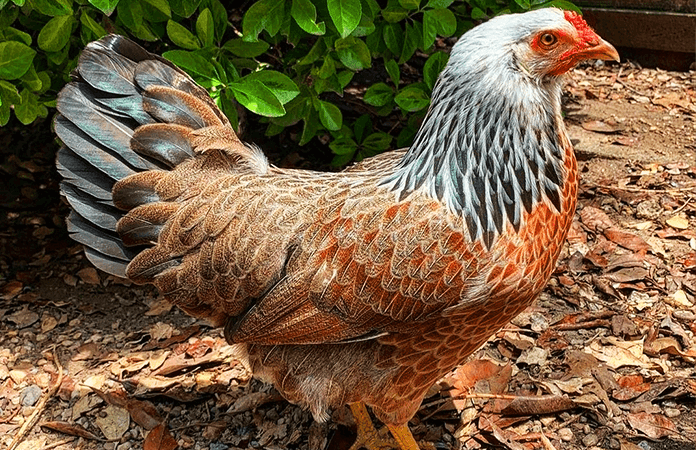
The Prairie Bluebell Egger is a relatively new breed, so don’t worry if you haven’t heard from them. They’re not that widespread yet. The Prairie Bluebell Egger is a hybrid bird, not a true chicken breed, and the offspring of a White Leghorn hen and an Araucana rooster.
| Eggs | 240 eggs per year |
| Egg Color | Blue |
| Egg Size | Medium |
| Weight | 4 – 5 lbs |
| Hardiness | Cold & heat |
| Temperament | Active and docile |
| Beginner-friendly | Yes |
| Color | Varies |
Prairie Bluebell Eggers, having a White Leghorn as one of its parents, are known for their great egg-laying capabilities. They lay around 240 medium-sized blue-colored eggs per year. That’s more than four eggs per week.
Pullets reach sexual maturity at five months of age and will begin to lay around that time, although this may vary from bird to bird.
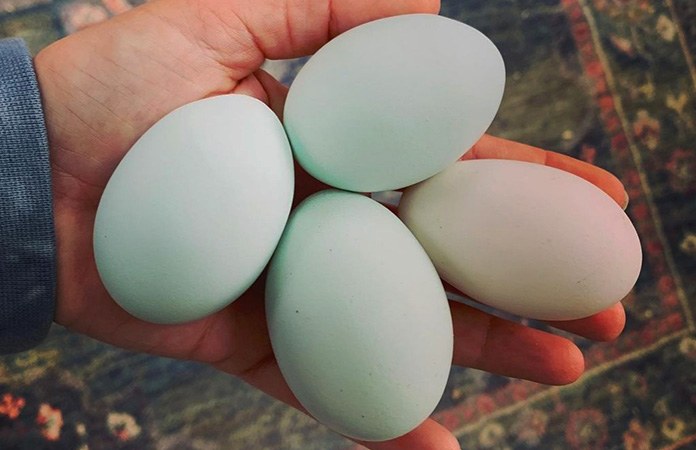
Prairie Bluebell Egger chickens are easygoing, beginner-friendly chickens. They’re both cold and heat-hardy, making them suitable for almost any climate. They love to free-range and need enough space to stay happy and healthy.
Hoover’s Hatchery recently created a green egg layer from crossing a Prairie Bluebell Egger with a brown egg layer. The Starlight Green Egger is a hatchery mix laying up to 280 green eggs yearly.
9. Faverolles
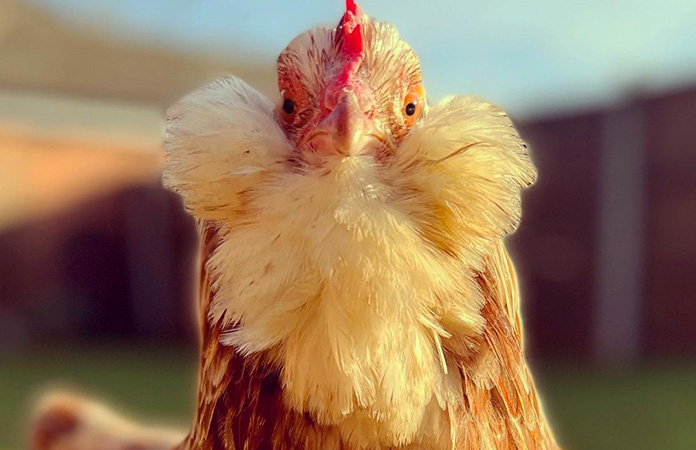
Faverolles chickens are a very fluffy and friendly French breed. They have a distinctive look with their large body, fluffy beard, and muffs. Although Faverolles chickens are brown egg layers, they are genetically predisposed to produce pink blooms that make the egg look pink.
A reddish bloom covering a light brown egg creates a pinkish shine. The base off-white shell color mixes with the reddish bloom, turning the egg pastel pink. But we must be honest; most Faverolles hens lay light brown eggs.
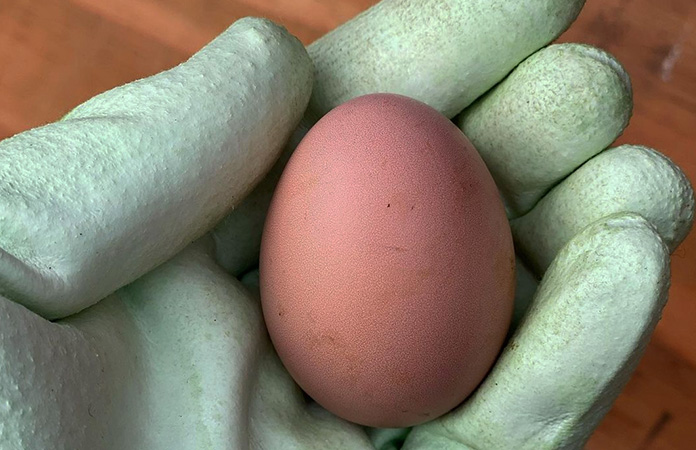
Faverolles are decent egg layers, laying three to four large eggs weekly. That’s up to 200 eggs per year. They start laying at the age of 20-22 weeks.
Faverolles make great pet chickens. They’re sweet, friendly, and kind and are a great asset to your backyard chicken flock, especially when having small children running around.
10. Sapphire Gem
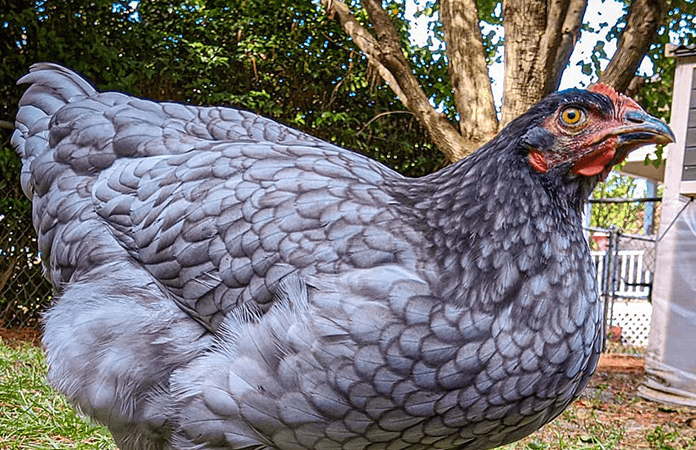
The Sapphire Gem is not a chicken breed but a cross-linked Plymouth Rock. The name Sapphire Gem is a retail name. They are lavender or blue in color and medium in size, which makes them suited as both meat and egg bird.
| Eggs | 250-290 eggs/year |
| Egg Color | Brown, Pink |
| Egg Size | (Extra) Large |
| Weight | 6-7 lbs |
| Hardiness | Cold & Heat |
| Temperament | Docile, Easy to Care For |
| Beginner-friendly | yes |
| Color | blue (light grey) |
Like the Faverolles chickens, Sapphire Gems lay brown to pink eggs, depending on the heaviness of the egg bloom, the protective cover on the egg’s surface. The pink-to-purple color results from reddish pigments in the bloom.
Sapphire Gems are excellent egg-layers and lay approximately 5 to 7 large light brown or pinkish eggs weekly. That’s an astonishing 260 to 290 eggs per year. Sapphire Gems need a lot of extra protein and calcium to produce that many large eggs.
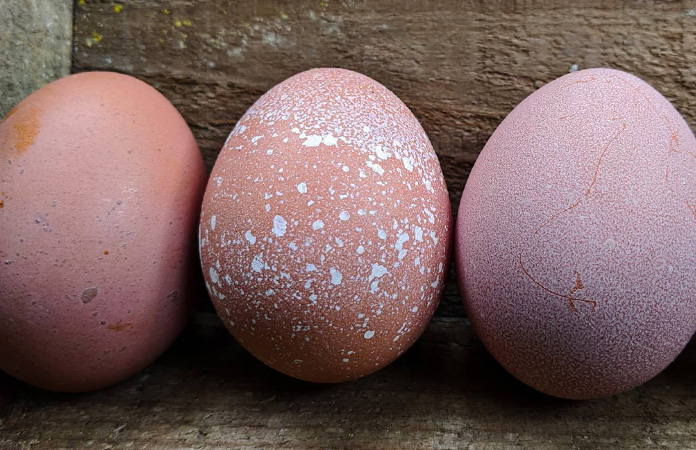
Sapphire Gems are very friendly birds that are easy to keep. That makes them beginner friendly and a good choice if you have small children or pets running around the coop.
How Does an Egg Get Its Color?
The eggshell gets its color from two pigments: brown color pigment and blue-green pigment. The genes of the chicken define the mixture of these pigments in the shell. The coloring of the shell occurs in the final hours of the egg-making process.
That being said, the egg color can also result from reddish pigments in the bloom, the protective layer on a chicken egg. In that case, the eggshell is (usually) brown, but the red pigments in the bloom make the egg appear pink or purple.
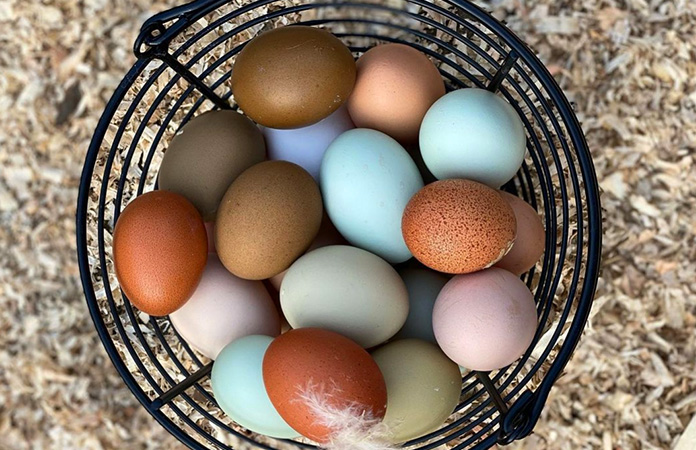
Do Chicken Earlobes Reveal the Egg Color?
The color of a chicken’s earlobe is often an indicator of the egg color, but there are exceptions. For instance, most chickens with white earlobes are expected to lay white eggs, but this is not always true. Lamona chickens have red earlobes and lay white eggs. Penedesencas have white earlobes but lay dark brown eggs.
If you want to learn more about how an egg color is made, check out our article on ‘Egg Color Genetics‘.
Summary
There are hundreds of chicken breeds! If you want to get to know them all, rare and common, go to our ‘All Chicken Breeds & Types Worldwide: List of 500+ Breeds‘.
We’re here to get you started if you aim to enrich your egg basket with various colors! Many excellent egg-laying chicken breeds that produce stunningly colored eggs, including blue, green, and chocolate brown, exist. We give you our top 10 laying chickens that produce beautifully colored eggs.
Further Reads
- Chicken Egg Color Genetics – an in-depth study on how genes control different egg colors
- Chicken Egg Color Chart – an overview of all chicken egg colors per breed
- 10 Fancy Chickens That Go Viral On Social Media – to explore extraordinary breeds
- Breeds – all our articles on chicken breeds
- Black Chicken eggs – busting some persistent myths about black eggs
- Green Egg Yolks – why do egg yolks turn green when they are hard boiled
- Chicken Egg Anatomy – overview of the anatomy of a chicken egg
- Chicken Genetics – an overview of chicken genetics and coloring
- Chicken Egg Anatomy – overview of the anatomy of a chicken egg
- Chicken Reproductive System – an overview of egg and eggshell formation
Credits Featured Image: @emseggers (IG)






















